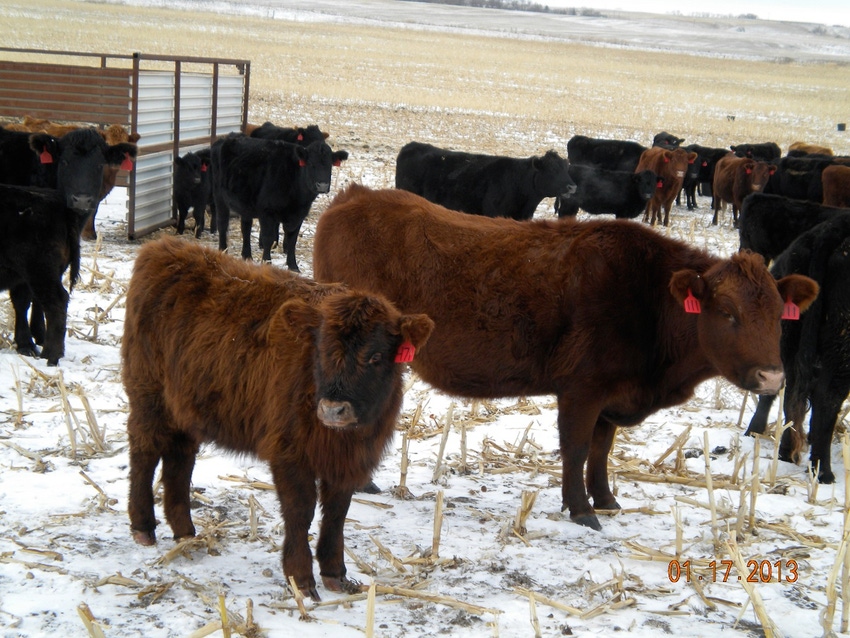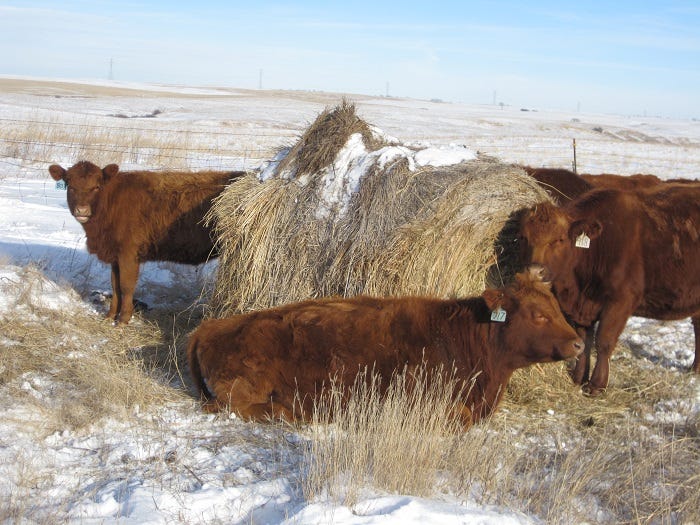September 3, 2018

Some ranchers who keep calves through winter to sell as yearling or heifer calves as replacements are finding they can winter those calves more efficiently and cheaply by leaving them on the cows.
This works very well for producers with a later calving season such as May/June. A growing number of beef producers are calving later so they have green grass at calving and less need for harvested forage when the cow’s nutritional needs are peaking during lactation. Along with later calving comes later weaning, so wintering the calves with the cows is a logical management progression.
Wintering pairs together is a new concept to many people in this country, but has been done in other places for a long time, such as in Australia and Africa. Experience is showing worldwide it can significantly cut wintering costs.
Cody and Deanna Sand six years ago started leaving calves on the cows through winter and weaning them in the spring at 10 months of age. The Sands run 250 pairs (plus bred heifers) on their ranch 140 miles southeast of Bismarck, in south-central North Dakota.
“We start calving the first of June so we wean about the first of April. The first few years, we just left heifer calves on the cows through winter and sold the steers in the fall. Then the market shifted and we decided to leave all the calves on their mothers through winter and grow out the steers as grass calves,” says Cody Sand.
“For winter feeding, it’s easier to have all the calves with their mothers rather than just half of them. One group instead of two means less labor, and all cows get treated equal, instead of having half of them not lactating. If one group needs supplement, it’s difficult, because we don’t want to split them.”
Earlier they wintered pairs on cornstalks 40 miles away for five months, but two years ago changed their winter feed program and kept the pairs home.
“We run on grass as long as we can. We also keep working at finding the right kind of cow, with efficiency and ability to eat for three (herself, her calf at side and her unborn calf). This is important for us, to raise cattle without a lot of input,” Sand explains.
The cattle have to be able to do it on their own and not fall out of the program.
“These are the traits we want in replacement heifers, and it gets better every year. It just takes time. We breed our heifers at 2 years old to calve at 3, but as our cattle become more efficient we might try to breed yearlings. We’d have a calf quicker, but we’re not sure if it would be the most profitable in the long run. If I have to keep those young cows separate and feed them separate (so they can raise their first calf and breed back again, without competition from the older cows for feed) or wean those calves quicker (instead of letting them winter with their mothers), this takes more labor and input. There are many factors to weigh to try to figure out which way is better,” he says.
“One thing I know is that I don’t ever want to wean a calf in the fall and feed it all winter. When we leave that calf on the cow it seems like we can feed the pair the same amount as if we had weaned the calf, and they all do fine. When we wean in April we put the calves on bale-grazing for two or three weeks until grass is green, and run the cows on stockpiled pastures. The cattle eat more after weaning than the pair together does. They are just more efficient somehow when they are together, but it is hard to explain because it doesn’t seem logical,” Sand says.
He says their experience with the winter efficiency of pairs compared with cows and calves kept separately is not unique.

Beef producers from a variety of environments say their calves seem to be more efficient when kept together with the cows through winter. These cows and calves in the Northern Plains are bale grazing.
“My neighbor 10 miles away runs his program similar to ours and started leaving his calves on the cows all winter. We had a bad winter and his cows were losing body condition, so he decided to wean in February instead of April. He called me mid-March and said he was still having to supplement his cows, and the calves were going through a phenomenal amount of hay. He realized that even though we can’t explain it, it just works better to leave them together and feed them as pairs.”
The Sands and others say Mother Nature apparently has cattle programmed to do this, as long as the cow has a chance to recover before calving again.
“This is the biggest reason not to calve early,” Sand says. "For us, the first of June works well. That’s when deer have their fawns. It’s amazing how the cows handle this. After a long winter we wondered if our cows would be ready to calve; even in mid-May they weren’t quite where we wanted them to be, in body condition. Something happened those last two weeks; they really turned around and we were happy with how they looked when they started calving."
Sands adds that harsh weather such as the cold of winter and spring storms is the easiest reason to see why it’s best to not calve early, but he thinks the bigger issue is nutrition. Calving later allows the cows extra time to rebound and be ready to calve and lactate.
It's better for the kids
Later calving and spring weaning may be more inheritance-friendly, says North Dakota rancher Nick Faulkner of the Ruso Ranch in central North Dakota.
“I don’t have to worry about some of the more labor-intensive ways to raise cattle; maybe we’re getting back to the way we think it should be. The next generation is more likely to want to farm/ranch and keep doing this if it’s not so difficult!"
"We’re trying to be more efficient. Right now if I ran a traditional ranching operation, I am not sure if my son (who is still young at this point) could have a future on the farm. If I can reduce the work load and inputs before we get to that point, it will be more doable,” says Faulkner. Keeping calves with their mothers through most of the winter can be part of this efficiency.
Faulkner on has been successfully wintering calves with their mothers for 12 years.
“We keep them on their mothers for about 10 months, pulling them off two months before the cows calve again. Every year we push the calving season back a little. Last year we started calving May 1 and it will be mid-May next year, and eventually we’ll calve in June, out on pasture,” Faulkner says.
“Later calving is easier, and has worked very well for us, along with wintering calves with their mothers,” he says. "We don’t have to give any vaccinations for scours or other calf diseases. Being on mother’s milk through winter, without the stress of weaning, keeps calves healthy.
Faulkner says they monitor their cows’ body condition through winter, but adds that their feeding program keeps most of them in good shape. They plant cover crops and put those up as hay to feed through winter, so cows get top-quality feed to help them keep body condition. Even if some of them lose a little weight, they typically bounce back before calving.
“Wintering pairs together simplifies our winter feeding program. My father-in-law raised corn for silage [for winter feed] for 30 years, and eight years ago we dropped that and no longer raise corn. We do more haying, but the calves go through winter much better on the cows than they do being weaned. We’re also bale grazing to reduce costs. It all ties together with later weaning. The calves are eating with the cows, whether bale grazing or pasture grazing, rather than waiting for the truck to bring feed.”
They are motivated to find their own feed and don’t become spoiled and lazy, he adds.
“We want our cattle working for us, rather than us working for them. The biggest thing I’ve noticed about later weaning is how much easier it is for all of us, and we have fewer problems and less sickness,” Faulkner says.
In addition, he says calves kept with their mothers through winter are not stressed at all by weaning. By February about 75% of them are already self-weaned because cows are kicking them off and drying up.
Building digestive efficiency
Better rumen development is another plus when you leave calves on their mothers for 10 months, says Cody Sand of North Dakota.
The calves do better since they have a fully developed rumen and are more efficient than if weaned at 5 or 6 months of age on a grain ration.
"Now we have many middle-aged cows in our herd that grew up this way. They were calves left on their mothers for 10 months. These cows seem to be the ones that are popping back in body condition better,” he says.
This is the natural way to wean. In nature, cattle suckled calves through winter, then kicked off the big calf the next summer when getting ready to have the next one. The older calf stays with mama and is never stressed, and weaning is a non-issue.
“My youngest son has two Highlander cows. We know a guy with a small herd of Highlanders who says he’s never weaned a calf. They stay in family groups and self-wean. We tried that with our son’s cows. His cows have baby calves now and the yearlings stay right with them but they don’t suck; just the baby does,” says Sand.
About the Author(s)
You May Also Like




